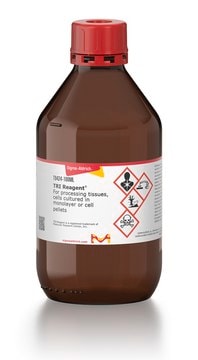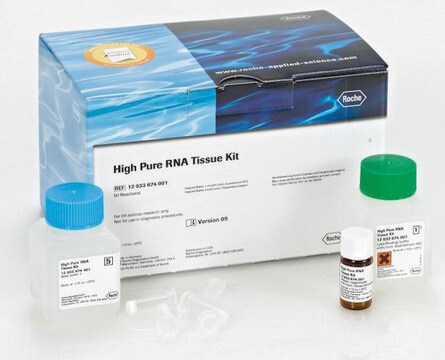推薦產品
一般說明
CHEMICON′s EX-WAX DNA Extraction Kit is intended to extract DNA from paraffin-embedded tissue fixed in 10% Formalin or non-crosslinking fixatives. DNA extracted by this kit is suitable for amplification by PCR.
Limitations:
The quality of extracted DNA is directly related to the quality of the embedded tissue. Harsh or extended fixation will adversely affect the results.
Summary and Principle
The EX-WAX DNA Extraction Kit is qualified on paraffin-embedded mammalian tissues fixed in 10% Formalin or non-crosslinking fixative. DNA is made accessible by protein digestion. DNA is solubilized, while digested proteins are "salted out" and spun to the bottom of the tube. DNA is precipitated, dried under vacuum, and resuspended. Once in solution, the DNA is suitable for amplification by PCR.
Warnings and Precautions
1. Wear gloves when isolating and handling DNA to minimize the activity of endogenous nucleases. Use autoclaved pipette tips and 1.5 ml microcentrifuge tubes for additional protection against nucleases.
2. Volumes are optimized for five 5 μm thick sections.
3. Qualified on tissue fixed in 10% Formalin or non-crosslinking fixative.
4. Not recommended for use with fresh, frozen tissues.
Limitations:
The quality of extracted DNA is directly related to the quality of the embedded tissue. Harsh or extended fixation will adversely affect the results.
Summary and Principle
The EX-WAX DNA Extraction Kit is qualified on paraffin-embedded mammalian tissues fixed in 10% Formalin or non-crosslinking fixative. DNA is made accessible by protein digestion. DNA is solubilized, while digested proteins are "salted out" and spun to the bottom of the tube. DNA is precipitated, dried under vacuum, and resuspended. Once in solution, the DNA is suitable for amplification by PCR.
Warnings and Precautions
1. Wear gloves when isolating and handling DNA to minimize the activity of endogenous nucleases. Use autoclaved pipette tips and 1.5 ml microcentrifuge tubes for additional protection against nucleases.
2. Volumes are optimized for five 5 μm thick sections.
3. Qualified on tissue fixed in 10% Formalin or non-crosslinking fixative.
4. Not recommended for use with fresh, frozen tissues.
應用
Preparation of Reagents
Protein Digesting Enzyme Solution
Add 1.25 ml of Sterile Distilled Water (supplied) to the vial of Protein Digesting Enzyme powder. Mix thoroughly. Store unused solution at -15°C to -25°C.
Extraction Procedure
1. Cut the tissue sections 5 μm thick. Use 3-5 sections for each extraction.
2. Cut away excess paraffin and place sections in a 1.5 ml tube. Spin briefly to pellet sections.
3. Add 1 ml of fresh 100% ethanol (room temperature) and gently vortex for 15 seconds.
4. Spin for 3 minutes in a microcentrifuge at 12,000 rpm.
5. Remove ethanol and dry pellet in a vacuum concentrator or at 60°C for 10 minutes with the cap open. If residual ethanol is still present, dry for another 10 minutes.
6. Add 150 μl of Digestion Solution and 50 μl of Protein Digesting Enzyme Solution to the tube and mix by stirring. Use the end of the micropipettor tip and physically mix the pellet into the solution. Do not pipette up and down (pellet will not dissolve).
7. Incubate for 4 hours to overnight at 50°C.
8. Add 100 μl of Extraction Solution and mix by inversion (at least 3 times) for 15 seconds. Over-mixing will excessively shear the DNA.
9. Spin in a microcentrifuge for 10 minutes at 12,000 rpm. Remove the supernatant and place it in a fresh 1.5 ml tube. This is accomplished by carefully poking the pipette tip through the paraffin layer on top and withdrawing the supernatant, leaving the paraffin and the pellet behind (see Figure 1). If small amounts of paraffin are removed with the supernatant, they will not affect the extraction.
10. Add 150 μl of Precipitation Solution to the supernatant, invert the tube 3 times, then add 900 μl of ice cold (-20°C) 100% ethanol. Cap the tube and invert several times to mix.
11. Place at -20°C for at least 1 hour.
12. Spin in a microcentrifuge for 10 minutes at 12,000 rpm. Discard the supernatant.
13. Dry the pellet in a vacuum concentrator or at 60°C with the cap open for 10 minutes. If residual ethanol is still present, dry for another 10 minutes.
14. Add 50 μl of Resuspension Solution and incubate for 1 hour at 50°C in a water bath.
15. Use 1 μl of resuspended DNA for each PCR reaction and run appropriate PCR controls.
Troubleshooting
1. When resuspending the DNA in Resuspension Solution, do not heat the DNA higher than 55°C. This will cause degradation of the DNA.
2. If the PCR reaction fails, check for the presence and quality of the DNA as follows: Run 10 μl of extracted sample DNA and molecular weight markers on a 0.8% agarose minigel using a 3 mm (width) toothed comb. Run the bromophenol blue dye front approximately 5 cm into the gel. If no sample DNA is observed, try adding 10-40 μl of sample DNA to the PCR reaction or extract a greater number of tissue sections. If the amount of tissue in the block is small, extract more sections, but if the amount of tissue is very large, you may want to try less.
Protein Digesting Enzyme Solution
Add 1.25 ml of Sterile Distilled Water (supplied) to the vial of Protein Digesting Enzyme powder. Mix thoroughly. Store unused solution at -15°C to -25°C.
Extraction Procedure
1. Cut the tissue sections 5 μm thick. Use 3-5 sections for each extraction.
2. Cut away excess paraffin and place sections in a 1.5 ml tube. Spin briefly to pellet sections.
3. Add 1 ml of fresh 100% ethanol (room temperature) and gently vortex for 15 seconds.
4. Spin for 3 minutes in a microcentrifuge at 12,000 rpm.
5. Remove ethanol and dry pellet in a vacuum concentrator or at 60°C for 10 minutes with the cap open. If residual ethanol is still present, dry for another 10 minutes.
6. Add 150 μl of Digestion Solution and 50 μl of Protein Digesting Enzyme Solution to the tube and mix by stirring. Use the end of the micropipettor tip and physically mix the pellet into the solution. Do not pipette up and down (pellet will not dissolve).
7. Incubate for 4 hours to overnight at 50°C.
8. Add 100 μl of Extraction Solution and mix by inversion (at least 3 times) for 15 seconds. Over-mixing will excessively shear the DNA.
9. Spin in a microcentrifuge for 10 minutes at 12,000 rpm. Remove the supernatant and place it in a fresh 1.5 ml tube. This is accomplished by carefully poking the pipette tip through the paraffin layer on top and withdrawing the supernatant, leaving the paraffin and the pellet behind (see Figure 1). If small amounts of paraffin are removed with the supernatant, they will not affect the extraction.
10. Add 150 μl of Precipitation Solution to the supernatant, invert the tube 3 times, then add 900 μl of ice cold (-20°C) 100% ethanol. Cap the tube and invert several times to mix.
11. Place at -20°C for at least 1 hour.
12. Spin in a microcentrifuge for 10 minutes at 12,000 rpm. Discard the supernatant.
13. Dry the pellet in a vacuum concentrator or at 60°C with the cap open for 10 minutes. If residual ethanol is still present, dry for another 10 minutes.
14. Add 50 μl of Resuspension Solution and incubate for 1 hour at 50°C in a water bath.
15. Use 1 μl of resuspended DNA for each PCR reaction and run appropriate PCR controls.
Troubleshooting
1. When resuspending the DNA in Resuspension Solution, do not heat the DNA higher than 55°C. This will cause degradation of the DNA.
2. If the PCR reaction fails, check for the presence and quality of the DNA as follows: Run 10 μl of extracted sample DNA and molecular weight markers on a 0.8% agarose minigel using a 3 mm (width) toothed comb. Run the bromophenol blue dye front approximately 5 cm into the gel. If no sample DNA is observed, try adding 10-40 μl of sample DNA to the PCR reaction or extract a greater number of tissue sections. If the amount of tissue in the block is small, extract more sections, but if the amount of tissue is very large, you may want to try less.
成分
Sufficient reagents to perform 20 DNA extractions containing three to five 5 μm thick tissue sections per extraction.
90442 Sterile Distilled Water (clear) 1.25 ml Room temp.
90443 Digestion Solution 3.0 ml Room temp.
90444 Extraction Solution 2.0 ml Room temp.
90445 Precipitation Solution 3.0 ml Room temp.
90446 Resuspension Solution 2.0 ml Room temp.
90447 Protein Digesting 25 mg -15 to -25°C
Enzyme (Powder)
90442 Sterile Distilled Water (clear) 1.25 ml Room temp.
90443 Digestion Solution 3.0 ml Room temp.
90444 Extraction Solution 2.0 ml Room temp.
90445 Precipitation Solution 3.0 ml Room temp.
90446 Resuspension Solution 2.0 ml Room temp.
90447 Protein Digesting 25 mg -15 to -25°C
Enzyme (Powder)
法律資訊
CHEMICON is a registered trademark of Merck KGaA, Darmstadt, Germany
免責聲明
Unless otherwise stated in our catalog or other company documentation accompanying the product(s), our products are intended for research use only and are not to be used for any other purpose, which includes but is not limited to, unauthorized commercial uses, in vitro diagnostic uses, ex vivo or in vivo therapeutic uses or any type of consumption or application to humans or animals.
訊號詞
Danger
危險分類
Eye Irrit. 2 - Resp. Sens. 1 - Skin Irrit. 2 - STOT SE 3
標靶器官
Respiratory system
儲存類別代碼
10 - Combustible liquids
分析證明 (COA)
輸入產品批次/批號來搜索 分析證明 (COA)。在產品’s標籤上找到批次和批號,寫有 ‘Lot’或‘Batch’.。
V Vaccaro et al.
BioMed research international, 2014, 351252-351252 (2014-05-31)
No established chemotherapeutic regimen exists for the treatment of recurrent malignant gliomas (rMGs). Herein, we report the activity and safety results of the bevacizumab (B) plus fotemustine (FTM) combination for the treatment of rMGs. An induction phase consisted of B
Ilse Vlassenbroeck et al.
The Journal of molecular diagnostics : JMD, 10(4), 332-337 (2008-06-17)
Epigenetic silencing of the DNA repair protein O(6)-methylguanine-DNA methyltransferase (MGMT) by promoter methylation predicts successful alkylating agent therapy, such as with temozolomide, in glioblastoma patients. Stratified therapy assignment of patients in prospective clinical trials according to tumor MGMT status requires
Alessandra Fabi et al.
BMC cancer, 9, 101-101 (2009-04-02)
In recurrent malignant gliomas (MGs), a high rate of haematological toxicity is observed with the use of fotemustine at the conventional schedule (100 mg/m(2) weekly for 3 consecutive weeks followed by triweekly administration after a 5-week rest period). Also, the
Roger Stupp et al.
Journal of clinical oncology : official journal of the American Society of Clinical Oncology, 28(16), 2712-2718 (2010-05-05)
Invasion and migration are key processes of glioblastoma and are tightly linked to tumor recurrence. Integrin inhibition using cilengitide has shown synergy with chemotherapy and radiotherapy in vitro and promising activity in recurrent glioblastoma. This multicenter, phase I/IIa study investigated
Monika E Hegi et al.
The New England journal of medicine, 352(10), 997-1003 (2005-03-11)
Epigenetic silencing of the MGMT (O6-methylguanine-DNA methyltransferase) DNA-repair gene by promoter methylation compromises DNA repair and has been associated with longer survival in patients with glioblastoma who receive alkylating agents. We tested the relationship between MGMT silencing in the tumor
我們的科學家團隊在所有研究領域都有豐富的經驗,包括生命科學、材料科學、化學合成、色譜、分析等.
聯絡技術服務







